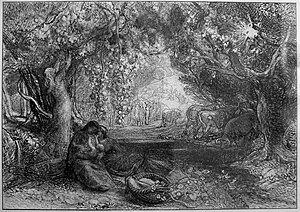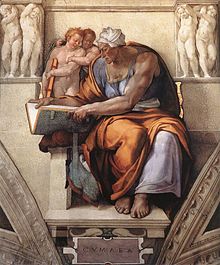Christian interpretations of Virgil's Eclogue 4

This belief persisted into the Medieval era, with many scholars arguing that Virgil not only prophesied Christ prior to his birth but also that he was a pre-Christian prophet. Dante Alighieri included Virgil as a main character in his Divine Comedy, and Michelangelo included the Cumaean Sibyl on the ceiling painting of the Sistine Chapel (a reference to the widespread belief that the Sibyl herself prophesied the birth of Christ, and Virgil used her prophecies to craft his poem). Modern scholars, such as Robin Nisbet, tend to eschew this interpretation, arguing that seemingly Judeo-Christian elements of the poem can be explained through means other than divine prophecy.
Background
The scholarly consensus is that Virgil began the hexameter
By the thirteenth and fourteenth centuries AD, Virgil had gained a reputation as a
History
Early interpretations
According to Classicist Domenico Comparetti, in the
The first major proponent that the poem was prophetic was likely the early Christian writer
Constantine himself also believed the poem could be interpreted as a prophecy about Christ. Many copies of the Roman historian
Several decades later,
The opinion that Eclogue 4 was a reference to the coming of Jesus was not universally held by early members of the early Church, however.
Medieval interpretations

In the early part of the sixth century, Latin grammarian Fabius Planciades Fulgentius made a passing reference to the supposed prophetic nature of the Fourth Eclogue, noting: In quarta vaticinii artem adsumit ("In the Fourth [Eclogue], [Virgil] takes up the art of prophecy").[24] However, his view seems to have been a bit nuanced, and in one of his books, he wrote that "no one is permitted to know all the truth except ... Christians, on whom shines the sun of truth. But [Virgil did] not come as an expositor well-versed in [the] books of Scripture."[25][26][nb 2] Craig Kallendorf writes that this indicated Fulgentius's belief that "there [were] limits to what ... Virgil knew about Christianity."[25]
According to legend,
In the eleventh century, Virgil began appearing in plays, such as one particular Christmas work wherein the poet is the last "prophet" called on to give testimony concerning Christ. According to Bourne, the play was particularly popular, and philologist

Virgil eventually became a fixture of Medieval ecclesiastic art, appearing in churches, chapels, and even cathedrals, sometimes depicted holding a scroll with a select passage from the Fourth Eclogue on it.[31] At other times, he "figured in sacred pictures ... in the company of David, Isaiah and other [Judeo-Christian] prophets".[27] Virgil's popularity in Medieval art is likely why Michelangelo included the Cumaean Sibyl on the ceiling painting of the Sistine Chapel, for, according to Paul Barolsky, the Sibyl's presence "evokes her song in Virgil [i.e. the Fourth Eclogue], prophesying spiritual renewal through the coming of Christ—the very theme of the ceiling."[32] Barolsky also points out that Michelangelo painted the Sibyl in close proximity to the prophet Isaiah; thus, the painter drew a visual comparison between the similar nature of their prophecies.[32]
This association between Virgil and Christianity reached a fever pitch in the fourteenth century, when the Divine Comedy was published; the work, by Dante Alighieri, prominently features Virgil as the main character's guide through Hell.[33] Notably, in the second book Purgatorio, Dante and Virgil meet the poet Statius, who, having "read a hidden meaning in lines of Virgil's own" (that is, Eclogue 4.5–7), was allowed passage into Purgatory, and eventually Heaven.[4][34][35] (This legend had developed earlier in the Middle Ages, but Dante's reference popularized it.)[27] Bourne argues that Dante's inclusion of Statius's conversion through Virgil's poem is proof enough that Dante, like those before him, believed Virgil to have been an unknowing Christian prophet.[34] Kallendorf notes that because writing the lines did not save Virgil, but reading them saved Statius, "Dante ... must have located the Christinization of Eclogue 4 in the reader rather than the writer."[35]
In the fifteenth century, a popular story concerning Secundian, Marcellian and Verian—who started out as persecutors of Christians during the reign of the Roman emperor Decius—emerged. The story claims that the trio were alarmed by the calm manner in which their Christian victims died, and so they turned to literature and chanced upon Eclogue 4, which eventually caused their conversions and martyrdom.[34] Around this time, the famed astrologer and humanist philosopher Marsilio Ficino seems to have accepted that the poem was a prophecy, too.[27]
Later interpretations
The French writer René Rapin (1621–1687) was fascinated with the potential connection between Virgil and Christianity, and used the Fourth Eclogue as an artistic influence, basing many of his lines in his own Sixth Eclogue on Virgil's work. One of the more overt modern references to the Fourth Eclogue, Virgil, and Christianity, appears in Alexander Pope's 1712 poem, Messiah. Bourne wrote that the work "shows clearly that [Pope] believed that Virgil's poem was based on a Sibylline prophecy".[36] Robert Lowth seems also to have held this opinion, noting, by way of Plato, that the poem contains references made "not by men in their sober senses, but [by] the God himself".[36] In the mid-19th century, Oxford scholar John Keble claimed: Taceo si quid divinius ac sanctius (quod credo equidem) adhaeret istis auguriis ("I am silent about whether something more divine and sacred—which is what I, in fact, believe—clings to these prophecies").[37]
Modern views
By the turn of the 20th century, most scholars had abandoned the idea that the Fourth Eclogue was prophetic, although "there [were] still some to be found who", in the words of Comparetti, "[took] this ancient farce seriously."[38] Robin Nisbet has argued that the supposed Christian nature of the poem is a by-product of Virgil's creative references to disparate religious texts; Nisbet proposes that Virgil probably appropriated some elements used in the poem from Jewish mythology by means of Eastern oracles. In doing so, he adapted these ideas to Western (which is to say, Roman) modes of thought.[39]
See also
- Interpretatio Christiana, the adaptation of non-Christian elements of culture or historical facts to the worldview of Christianity
Notes
- ^ Sabine MacCormack, citing R. G. M. Nisbet, notes that Lactantius's belief "was not without objective merit", as it is possible that Virgil was appropriating aspects of Judeo-Christians prophecy by way of Eastern oracles.[18]
- ^ Fulgentius's original Latin is written as if Virgil himself were saying it. The text in this article has been amended so that it is in third rather than first person.
References
- ^ Fowler (1996), p. 1602.
- ^ Morwood (2008), p. 5.
- ^ Rose (1924), p. 114.
- ^ a b c d Bourne (1916), p. 391.
- ^ Davis (2010), p. x.
- ^ Rose (1924), p. 113.
- ^ Vitto (1989), pp. 36–49.
- ^ Conte (1999), p. 267.
- ^ a b Bourne (1916), pp. 390–2.
- ^ a b c d e Comparetti (1895), p. 101.
- ^ a b c Comparetti (1895), p. 100.
- ^ a b c Kallendorf (2015), 51.
- ^ Kallendorf (2015), 52.
- ^ Bourne (1916), p. 392.
- ^ Pelikan (1999), p. 37.
- Divinae Institutiones7.24.
- ^ MacCormack (1998), p. 25.
- ^ MacCormack (1998), p. 25, note 82.
- ^ a b c Pelikan (1999), p. 36.
- ^ Constantine apud Eusebius, Oratio ad coetum sanctorum 19–21.
- Augustine, Epistolae ad Romanos inchoata expositio 1.3.
- ^ Bourne (1916), p. 392–393.
- Augustine, De civitate Dei, 10.27.
- ^ a b c Bourne (1916), p. 393.
- ^ a b Kallendorf (2015), 54.
- ^ Fabius Planciades Fulgentius, Expositio Virgilianae continentiae secundum philosophos moralis, 23–24.
- ^ a b c d Comparetti (1895), p. 102.
- ^ Bourne (1916), pp. 393–4.
- ^ Bourne (1916), pp. 394–5.
- ^ Bourne (1916), pp. 395–6.
- ^ Bourne (1916), pp. 396–7.
- ^ a b Barolsky (2007), p. 119.
- ^ Bourne (1916), pp. 397–8.
- ^ a b c Bourne (1916), p. 398.
- ^ a b Kallendorf (2015), 56.
- ^ a b Bourne (1916), p. 399.
- ^ Bourne (1916), p. 400.
- ^ Comparetti (1895), p. 103.
- ^ Nisbet (1978), p. 71.
Bibliography
- Bourne, Ella (April 1916). "The Messianic Prophecy in Vergil's Fourth Eclogue". JSTOR 3287925.
- Conte, Gian Biagio (1999). Latin Literature: A History. ISBN 9780801862533.
- Fowler, Don (1996). "Virgil (Publius Vergilius Maro)". In Hornblower, Simon; Spawforth, Antony (eds.). The Oxford Classical Dictionary (3 ed.). ISBN 9780198661726.
- Gregson, Davis (2010). "Introduction". Virgil's Eclogues. Translated by Krisak, Len. ISBN 9780812205367.
- Kallendorf, Craig (2015). The Protean Virgil: Material Form and the Reception of the Classics. ISBN 9780198727804.
- MacCormack, Sabine (1998). The Shadows of Poetry: Vergil in the Mind of Augustine. ISBN 9780520920279.
- Morwood, James (2008). "Eclogues" (PDF). Virgil, A Poet in Augustan Rome. ISBN 9780521689441.
- Nisbet, R. G. M. (1978). "Virgil's Fourth Eclogue: Easterners and Westerners". Bulletin of the Institute of Classical Studies. 25 (1). .
- Pelikan, Jaroslav (1999). Jesus Through the Centuries: His Place in the History of Culture. ISBN 9780300079876.
- Rose, H. J. (1924). "Some Neglected Points in the Fourth Eclogue". S2CID 170727145.
- Vitto, Cindy (1989). The Virtuous Pagan in Middle English Literature. ISBN 9780871697950.
- Attribution
 This article incorporates text from this source, which is in the JSTOR 3287925.
This article incorporates text from this source, which is in the JSTOR 3287925.
External links
 English Wikisource has original text related to this article: English translation of Eclogue 4
English Wikisource has original text related to this article: English translation of Eclogue 4- Full Latin text of Eclogue 4, courtesy of the Perseus Project.
